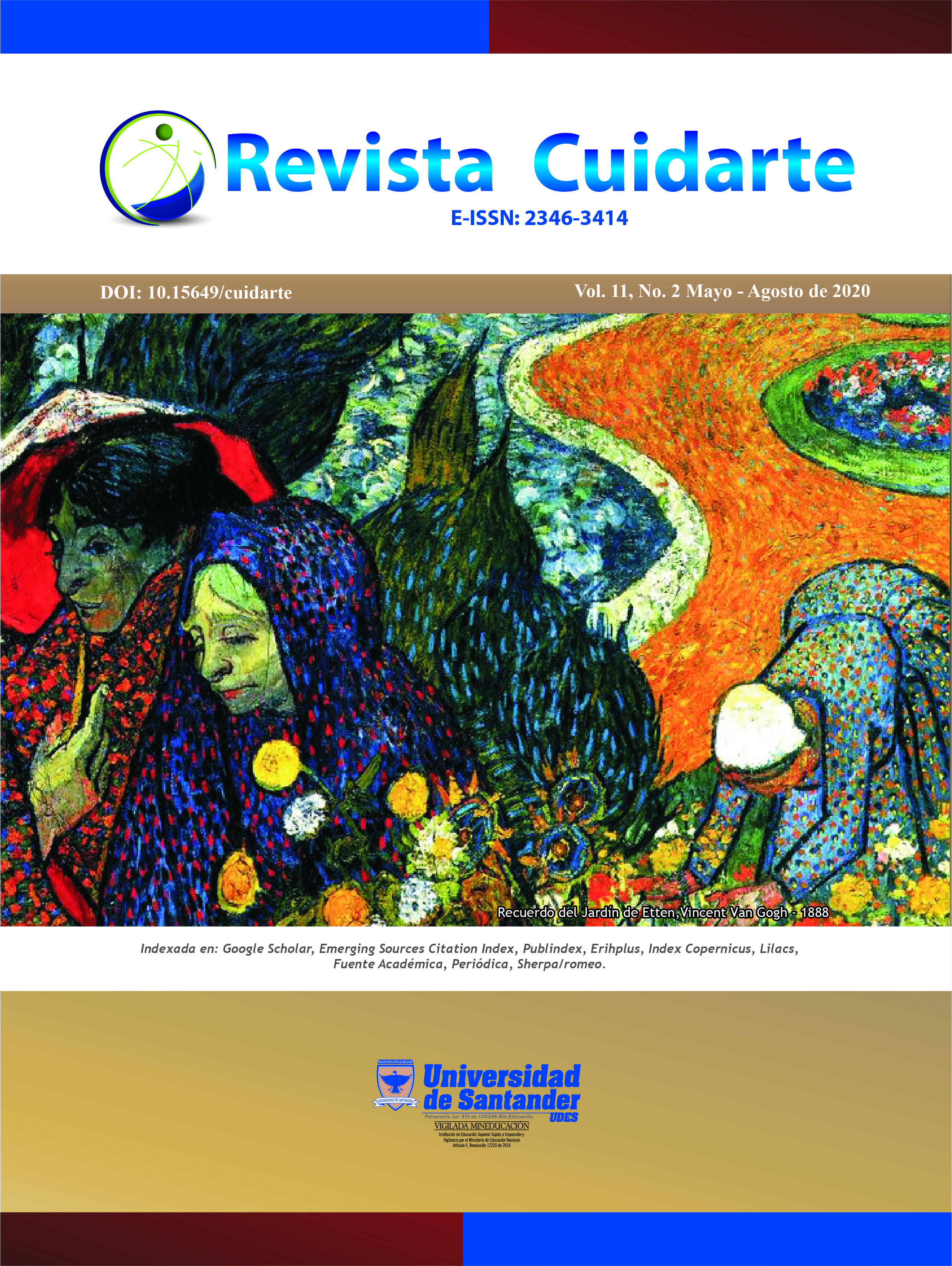"Establishing the Dialogic Bond that Relieves": A View from an Aesthetic Pattern
DOI:
https://doi.org/10.15649/cuidarte.1086Keywords:
Coronary Disease, Treatment Adherence and Compliance, Nursing Care, Qualitative Research, CommunicationAbstract
Introduction: Cardiovascular disease is the second leading cause of morbidity and mortality worldwide, which generates social and economic burden. Poor adherence to cardiovascular medication is associated with multiple risks. Objective: To describe the category “Establishing the dialogic bond that relieves from the aesthetic pattern.” Materials and Methods: A qualitative study based on Corbin and Strauss’ theory was conducted with twelve participants. Data were collected using in-depth interviews. In the analysis, texts were line-by-line coded and codes were labeled, which gave rise to subcategories and categories. Then the data were examined on a theoretical basis and categories were integrated and refined. Results: ‘Establishing the dialogic bond that relieves’ is composed by the subcategories ‘experiencing an environment of affection and confidence for learning: creating empathy’ and ‘establishing connections of care that provide satisfaction and build positive feelings of the dialogic encounter.’ Discussion: Establishing the dialogic bond that relieves is part of aesthetic knowledge as one of the patterns of knowledge described as "the art of nursing" that was identified by Carper. It is characterized by being intangible and does not go beyond the context of each individual's personal experience. Conclusions: The dialogic bond that relieves is a genuine encounter that allows creative nurse-patient interaction, experienced through words and gestures that expand the consciousness of human beings experiencing coronary heart disease and requiring chronic treatment to control the disease.
How to cite this article: Arango Restrepo María Cristina, Salazar Maya Angela María. Estableciendo vínculos dialógicos que alivian”: una mirada desde el patrón estético. Revista Cuidarte. 2020; 11(2): e1086. http://dx.doi.org/10.15649/cuidarte.1086
References
Bowry ADK, Lewey J, Dugani SB, Choudhry NK. The Burden of Cardiovascular Disease in Low- and Middle-Income Countries: Epidemiology and Management. Can J Cardiol. 2015; (31): 1151-59. https://doi.org/10.1016/j.cjca.2015.06.028
Organización Mundial de sal salud. Estadísticas Enfermedades Cardiovasculares.
Al-Ganmi AH, Perry L, Gholizadeh L, Alotaibi AM. Cardiovascular medication adherence among patients with cardiac disease: a systematic review. J Adv Nurs. 2016; 72(12): 3001-14. https://doi.org/10.1111/jan.13062
Chowdhury R, Rasheeqa IS, Tsoli S. Therapy-related strategies to improve adherence to cardiovascular medications. Medicographia 2017; 39(4): 280-88.
Saag KG, Bhatia S, Mugavero MJ, Singh JA. Taking an Interdisciplinary Approach to Understanding and Improving Medication Adherence. J Gen Intern Med. 2018; 33(2): 136-38. https://doi.org/10.1007/s11606-017-4215-7
Chen H-Y, Saczynski JS, Lapane KL, Kiefe CI, Goldberg RJ. Adherence to evidence-based secondary prevention pharmacotherapy in patients after an acute coronary syndrome: A systematic review. Heart Lung. 2015; 44(4): 299- 308. https://doi.org/10.1016/j.hrtlng.2015.02.004
Vargas OMO, Herrera C, Rocha L. Aportes para el abordaje interdisciplinar de la adherencia al tratamiento. Acta Med Colomb. 2018; 43(1): 37-41. https://doi.org/10.36104/amc.2018.781
Pisano GMM, González PA. La modificación de los hábitos y la adherencia terapéutica, clave para el control de la enfermedad crónica. Enferm Clin. 2014;24(1):59-66. https://doi.org/10.1016/j.enfcli.2013.10.006
Young HN, Len-Rios ME, Brown R, Moreno MM, Cox E. How does patient-provider communication influence adherence to asthma medications?. Patient Educ Couns.2017;100(4):696-702. https://doi.org/10.1016/j.pec.2016.11.022
Capone V. Patient communication self-efficacy, self-reported illness symptoms, physician communication style and mental health and illness in hospital outpatients. J Health Psychol. 2016;21(7):1271-82. https://doi.org/10.1177/1359105314551622
Brown MT, Bussell J, Dutta S, Davis K, Strong S, Mathew S. Medication adherence: truth and consequences. Am J Med Sci. 2016;351(4):387-99. https://doi.org/10.1016/j.amjms.2016.01.010
Flickinger TE, Saha S, Roter D, Korthuis PT, Sharp V, Cohn J, et al. Clinician empathy is associated with differences in patient–clinician communication behaviors and higher medication self-efficacy in HIV care. Patient Educ Couns. 2016 ;99(2):220-226. https://doi.org/10.1016/j.pec.2015.09.001
Meleis AI. Transitions theory. En: Smith MC, Parker ME. Nursing Theories & Nursing Practice 4 ed. Philadelphia: F. A. Davis Company; 2015.
Corbin J, Strauss A. Basics of qualitative research. Techiques and procedures for developing grounded theory. 4 ed. Los Ángeles: SAGE; 2015
Taylor SJ, Bogdan R, DeVault M. Introduction to qualitative research methods: A guidebook and resource. 4 ed. New Yersey: John Wiley & Sons; 2015.
Ministerio de la Protección Social. República de Colombia. Resolución Nª 008430 de 1993. Por la cual se establecen las normas científicas, técnicas y administrativas para la investigación en salud.
Carper B. Fundamental patterns of knowing in nursing. Adv Nurs Sci 1978; 1(1):13-23. https://doi.org/10.1097/00012272-197810000-00004
Bender M, Elias D. Reorienting Esthetic Knowing as an Appropriate "Object" of Scientific Inquiry to Advance Understanding of a Critical Pattern of Nursing Knowledge in Practice. ANS Adv Nurs Sci. 2017; 40(1):24-36. https://doi.org/10.1097/ANS.0000000000000160
Siles-Gonzalez J, Solano-Ruiz C. Sublimity and beauty: A view from nursing aesthetics. Nurs Ethics. 2016;23(2):154-66. https://doi.org/10.1177/0969733014558966
Orem D. Nursing: Concepts of Practice. 6th ed. St Louis. Mosby; 2001.
Chinn PL, Kramer MK. Knowledge Development in Nursing: Theory and Process. 10th ed. St Louis Missouri: Elsevier; 2018
Adams LY. The conundrum of caring in nursing. Int. J.Caring Sci 2016; 9(1): 1-8.
Radmehr M, Ashktorab T, Abedsaeedi Z. Nursing Care Aesthetic in Iran: A Phenomenological Study. Nurs Midwifery Stud. 2015; 4(2): e27639. https://doi.org/10.17795/nmsjournal27639
Carper B. The ethics of caring. Adv Nurs Sci 1979; 1(3): 11- 20. https://doi.org/10.1097/00012272-197904000-00004
Monteiro APTAV, Curado M, Queirós P. Biotechnology: digital revolution and aesthetic knowledge in nursing. Rev Enferm 2017; IV(13): 139-146. https://doi.org/10.12707/RIV17020
Published
How to Cite
Issue
Section
Altmetrics
Downloads
License
Journal Cuidarte, scientific publication of open access, is licensed under a Creative Commons Attribution (CC BY-NC), which permits use, distribution and reproduction in any medium, provided the original work is properly cited and is not used for commercial purposes.
Any other form of use such as reproduction, transformation, public communication or distribution, for profit, requires the prior authorization of the University of Santander UDES.
The names and e-mail addresses entered in the Journal Cuidarte will be used exclusively for the purposes stated by this magazine and will not be available for any other purpose or other person.
The articles published in the Journal Cuidarte represent the criteria of their authors and do not necessarily constitute the official opinion of the University of Santander UDES.







